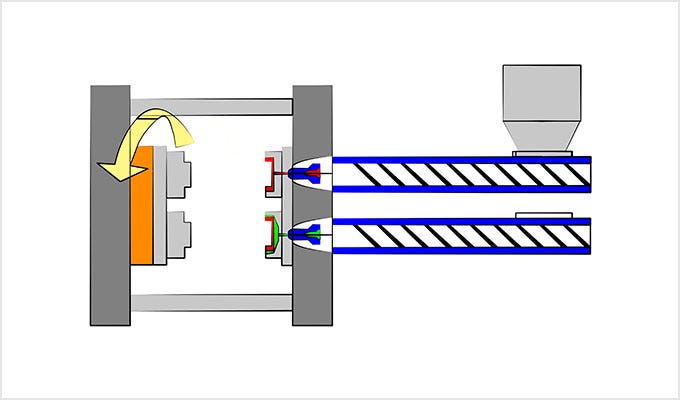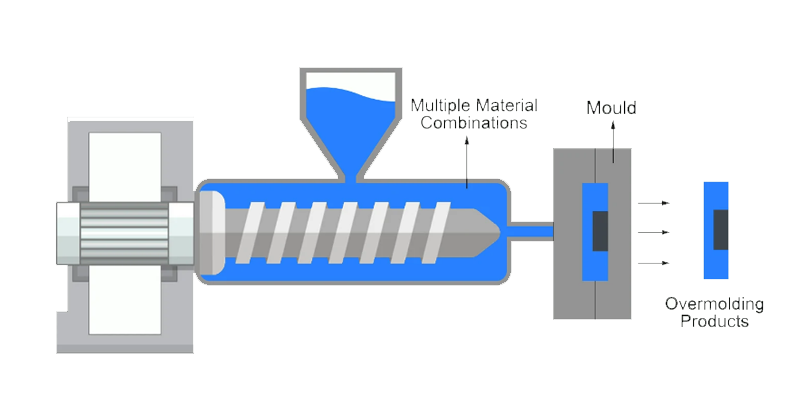Contents
In the ever-evolving landscape of manufacturing processes, innovative techniques continually emerge to meet the demands of efficiency, functionality, and aesthetics. Two such methods, Two-Shot Molding and Over-Molding, have garnered significant attention for their ability to create complex and multi-material parts. While both techniques achieve similar outcomes, understanding their differences is crucial for selecting the optimal solution for specific manufacturing needs. In this article, we delve into the intricacies of two-shot molding and over-molding, offering a comprehensive comparison to aid decision-making in manufacturing processes.

Two-Shot Molding:Enhancing Efficiency and Precision
Two-shot molding, also know as 2k or dual-shot injection molding, is a process where two difference materials are injected into a mold in a single operation. This technique enables the production of multi-material or multi-colored components without the need for secondary operations. The process typically involves the use of two injection units and a rotating or translating mold, allowing for precise placement of materials.
Key Advantages of Two-Shot Molding
- Enhanced Design Flexibility: Two-shot molding facilitates the integration of multiple materials within a single component, enabling designers to create complex geometries and incorporate different textures or functionalities.
- Improved Part Quality:By eliminating the need for secondary assembly processes, two-shot molding reduces the risk of part misalignment or inconsistencies, resulting in higher quality finished products.
- Cost Efficiency:While initial tooling costs may be higher compared to traditional molding techniques, two-shot molding can ultimately reduce overall production costs by streamlining processes and minimizing material waste.
Over-Molding: Achieving Superior Bonding and Functionality
Over-molding, also referred to as multi-material injection molding, involves the process of molding one material over another to create a single, integrated component. Typically, a substrate or base part is first molded, and then additional material is injected to form a layer over the substrate, providing enhanced functionality, durability, or aesthetic appeal.
Key Advantages of Over-Molding
- Enhanced Bonding:Over-Molding creates a strong bond between the substrate and the over-molded material, ensuring durability and longevity, particularly in applications where components are subjected to stress or environmental factors.
- Improved Ergonomics and Aesthetics: By encapsulating the substrate with a soft-touch or textured material, over-molding enhances grip, comfort, and visual appeal, making it deal for consumer products such as handles, grips, and electronic devices.
- Customization Options: Over-molding offers versatility in material selection, allowing manufacturers to tailor properties such as hardness, elasticity, and color to meet specific design requirements.

Comparative Analysis
While two-shot molding and over-molding share common objectives of creating multi-material components, they differ in several key aspects:
- Process Complexity: Two-shot molding requires specialized machinery equipped with multiple injection units and complex molds capable of precise rotation or translation. Over-molding, on the other hand, involves a simpler process of molding additional material onto an existing substrate, making it more accessible for certain applications.
- Material Compatibility:Two-shot molding is well-suited for combining materials with different properties, such as rigid and flexible polymers, or opaque and transparent resins. Over-molding, however, relies on the compatibility of materials to ensure proper adhesion and bonding between layers.
- Design Freedom: While both techniques offer design flexibility, two-shot molding excels in creating intricate geometries and incorporating multiple materials within a single part. Over-molding is particularly advantageous for adding functional or aesthetic features to existing components without altering their core structure.
How to Choose Between Two-Shot Molding and Over-Molding
Choosing between two-shot molding and over-molding requires careful consideration of various factors, including design requirements, material compatibility, production volume, and cost considerations. Here are some steps to help you make an informed decision:
- Define Design Requirements:Start by clearly defining the objectives and specifications of your part or product. Consider factors such as desired functionality, aesthetics, material properties, and any specific design constraints.
- Evaluate Material Compatibility: Assess the compatibility of materials required for your project. Two-shot molding allows for the integration of different materials within a single component, making it suitable for applications that demand combinations of rigid and flexible polymers or diverse material properties. On the other hand, over-molding relies on material compatibility to ensure proper bonding between layers.
- Consider Production Volume: Analyze the anticipated production volume of your project. Two-shot molding typically involves higher initial tooling costs but can offer cost savings and efficiency benefits for high-volume production runs due to reduced cycle times and elimination of secondary assembly processes. Over-molding may be more suitable for low to medium-volume production or prototyping projects where tooling costs are a significant consideration.
- Evaluate Design Complexity: Assess the complexity of the part geometry and any specific design features required. Two-shot molding excels in creating intricate geometries and incorporating multiple materials within a single part, making it suitable for complex designs with tight tolerances. Over-molding is particularly advantageous for adding functional or aesthetic features to existing components without altering their core structure.
- Consider Process Complexity:Evaluate the capabilities of your manufacturing equipment and resources. Two-shot molding requires specialized machinery equipped with multiple injection units and complex molds capable of precise rotation or translation. Over-molding involves a simpler process of molding addition material onto an existing substrate, making it more accessible for certain applications and potentially requiring less specialized equipment.
- Assess Cost Considerations: Conduct a cost analysis taking into account factors such as tooling costs, material costs, cycle times, labor costs, and any additional processing or finishing requirements. While two-shot molding may involve higher initial costs, it can offer long-term cost saving through reduced cycle times and elimination of secondary assembly processes. Over-molding may be more cost-effective for low to medium-volume production runs or projects with simpler design requirements.
Choosing the Right Supplier
When it comes to sourcing plastic mold parts for your manufacturing needs, partnering with reputable supplier is essential. HordRT is one such provider known for delivering high-quality plastic mold parts. Whether you require components for two-shot molding, over-molding, or any other injection molding processes, HordRT offers a range of solution to meet your specifications.
Conclusion
In summary, two-shot molding and over-molding are versatile techniques that enable the creation of complex, multi-material parts with enhanced functionality and aesthetics. The choice between the two depends on many factors. By understanding the differences and advantages of each method and partnering with a reliable supplier like HordRT, manufacturers can make informed decisions to optimize their manufacturing processes and deliver innovative solutions to market.
-q4gvl4k29y4hq8j9rjpapvj0ft06fje63olt7p210i.png)

